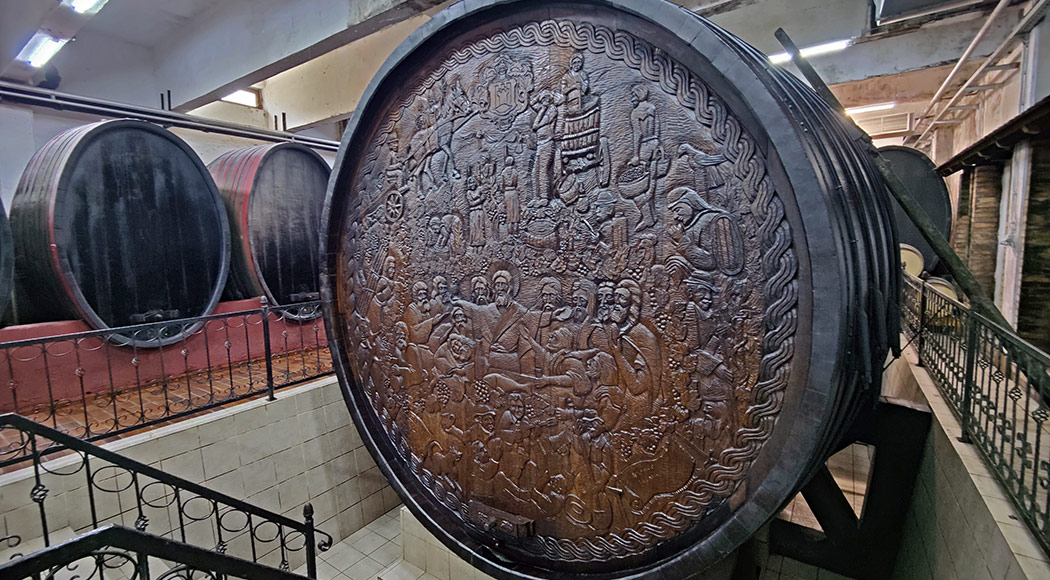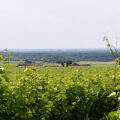Woe be the sommelier student who must remember the names of all the various bottle sizes lest they bring a diner a three liter Jeroboam of Moët et Chandon when in fact it was the nine liter Salmanazar that was requested… an embarrassment that shall never be lived down.
Unless a wine writer, most people won’t know that there are in fact various names for barrel sizes as well, that one should remember, at least in theory. I can never keep them straight and honestly, they’re all a bit flexible given that foudre is tossed around liberally for anything over 225/228l.
I will however let you know that there is (should be?) a name for what is the largest wine barrel in use, in the world, and that kind readers, is a ‘Jesus’ barrel.
I was not aware of the Jesus barrel until I went on a trip to Slavonija, Croatia where, at the winery of Erdustki Podrumi (located in the hilltop town of Erdut on the right bank of the Danube), my group was lured down to a lower part of the cellar and there it was, this massive oak barrel on its side that can apparently hold 75,000 liters of wine.
This we were told is the largest wine barrel in the world that’s actually making wine. Construction of it started in 1989 using 109 Slavonian oak trees–used in a great many barrels around the world. The maker of the barrel was DIK Đurđenovac which is now defunct and what was left of the factory burned in a fire back in 2015. I can only hope that no one bought any extended warranties.
The barrel had long been finished before these tragic events came to pass and it arrived to the Erdustki cellar in 1993. They’ve been producing a Graševina white wine from it ever since with this engraving on the front of it that features all aspects of winemaking, but most prominently, a life sized Jesus with arms outstretched, right in the middle.
But the question on anyone’s mind should be, “Is this actually the largest wine barrel in the world?”
One thing is for sure in that it’s far from being the largest wooden barrel in the world. That honor belongs to one for brewing soy sauce in Japan which clocks in a truly massive 540,000 liters in capacity.
If you want to talk specifically about wine barrels, then there’s the Heidelberg Tun which, when built in 1751 had a capacity of 221,726 litres. This however has only been used as a wine barrel on rare occasions and is more a tourist attraction for people to walk through at the Heidelberg Castle: “Come to the castle! Enjoy a huge wine barrel! With no wine!”
Likewise, the Foudre Mercier in Champagne is massive at 160,000l. Arriving in 1889 at the Exposition Universelle in Paris, “drawn by a team of 24 oxen all the way from Epernay”, it made quite a splash, but now is little more than a museum piece that’s not in active production.
I’ve seen other barrels that are very much in use which are near this size. The ancient oak fermentation vats at López de Heredia in Rioja are each 61,000 liters in size and while this is an old, established winery, there are bound to be others in use as well. For example the massive barrels used to produce vermouth at the cooperative of Falset-Marçà in DO Montsant tower over any of these, but, this is vermouth production, not wine.
It could very well be that this is one of the largest barrels for winemaking that exists and the reason for that is due modern production methods, in that it’s extremely difficult to control wine in an oak barrel of this size. The workers at the winery told me that they lose about 70l of wine a year through evaporation. This may seem like a bit, but it’s actually less than 0.001% of the total, which to me doesn’t seem like it’s being measured adequately or there was some kind of translation error as it’s usually around 3%, at least in smaller barrels.
I’ve seen similar issues before with large, sideways wine vessels, although not ones made of oak. I was in Armenia and the winery of Ijevan had these Soviet Era horizontal tanks for winemaking which they said they controlled oxidation issues in via use of SO2. The amount of SO2 you’d have to put into a wine to have that work would leave the wine patently undrinkable which is why upright, “always-full” stainless steel tanks have become so prevalent.
Whilst everyone in my visiting group took turns taking selfies in front of the Jesus barrel, we were offered a taste of the wine from the inside of it. My summary of it was basically, “Okay, but tastes like a wine lacking a manner of finite control.”
This barrel clearly makes for a fun visitor attraction, but I have to wonder if making wine in it, is really all that worthwhile, even with Jesus being right out there in the front giving it his blessing.

